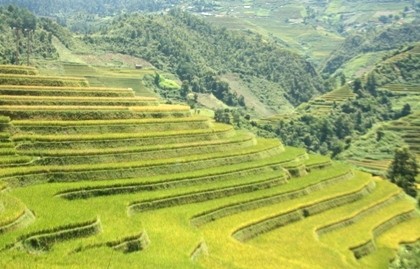Bat Trang, traditional porcelain and pottery village with
history of seven centuries, is an interesting attraction in Hanoi that
tourists should not ignore.
Bat Trang, a small village in the north
of Vietnam, is about 13 kilometers south east of Hanoi center, on the
other side of Chuong Duong bridge. Why is its name popular to most
tourists to northern Vietnam?
The answer is its ever famous ceramic and
pottery products of high quality. If you have known about Vietnam, you
may not be surprised that Bat Trang’s vases, bowls, dishes, and many
other kinds of ceramic products have been exported worldwide.
Should you
would like to contemplate workers making ceramic products by hand, just
come here! What’s more, you can also try it yourself!

Foreigners buy souvenir in Bat Trang village
History of Bat Trang village
Bat Trang village is said to be established in 14th or 15th
century in several documents. However, according to the villagers, the
village perhaps appeared earlier. There are always two stories
concerning the village origin.
One of these tells that under Ly dynasty,
in 1100, when the nation was in its independence and initial growth
period, there were 3 scholars who came back from their mission trip to
China bringing the ceramic craft industry learned there back to Vietnam and taught the people of Bat Trang.
In the other story, in the village history dates back to the 10th
century, when King Ly Cong Uan relocated the capital in Thang Long.
With the establishment and development of the capital, many businessmen,
crafters from many areas come to settle down here to work and trade.
In
Bat Trang, there was a lot of white clay, so that many potters, among
whom was Nguyen Ninh Trang family, came and built the kilns here.
Accordingly, Bat Trang has gradually changed from a normal ceramic and
pottery village into a famous ceramic and pottery centre until now.
As
time went by, the village’s products have developed and become well
known for the best quality, style and glaze, both inside and outside of
the nation. Many of these are now customized for aristocratic families
and religious needs. Its popular foreign markets are Japan (under the
brand "Kochi (Giao Chi) ware"), the Netherlands, Britain, Portugal,
Southeast Asia, etc.,
The famous ceramic & pottery products
Production Process : To
produce a complete product, one must follow 3 steps. The first step is
making the product frame. The artists select the suitable clay, treat it
and start making a raw product. It must be repaired to get the best
appearance. Secondly, they decorate and cover it with glazes.
Last but
not least, the raw products are baked in 3 days and 3 nights. There are
several kinds of kiln, yet the temperature must be at 12000 or 13000.
After baking, products are brought out, classified and repaired in case
there are mistakes. And now we have the perfect product.
 Decorating cearmic products
Decorating cearmic products
Popular product types. Bat Trang products are divided into 3 kinds based on the purpose of use.
- Utilitarian wares: including plates, bowls, teacups, kettles, wine bottles, flowerpots, vases, jar… What differs is that they are thicker than Chinese ones.
- Cult wares: comprise lamp stands, candle holders, incense burner, altar boxes, swords… These are valuable for collectors because of inscription of the production years, the names of the producers and the potters.
- Decorative objects: house models, altars, statues and architectural fixtures.

The special trait is the diversified decorations
on the products. Thanks to a long–lasting history and development, the
village’s works have been accumulated with a lot of different special
designs.
One more thing that makes them distinguished is the glaze, which is of high quality and a variety of colors, such as blue, brown, white, moss green, in both breaking and melting glazes.
In
fact, there have appeared a number of competitors both domestically and
internationally who take advantages of high technology. Yet most
customers prefer the craft products that contain historical and
traditional values. Hence, it is no surprise at all that Bat Trang is
still found in busy days and works. More importantly, the village is now
so popular that absorbs a huge annual number of tourists to visit and
buy ceramic goods.


















 It’s
closely related to a legendary story that Nguyễn Cả, a famous man in
the village and a general of emperor Đinh Tiên Hoàng who refused high
rank for his merits to return to home village and instructed his
home-villagers in cultivation. In his life’s last days, he lived in
modesty and taught young people games and sports, of these kite-flying
is still exciting.
It’s
closely related to a legendary story that Nguyễn Cả, a famous man in
the village and a general of emperor Đinh Tiên Hoàng who refused high
rank for his merits to return to home village and instructed his
home-villagers in cultivation. In his life’s last days, he lived in
modesty and taught young people games and sports, of these kite-flying
is still exciting.
















